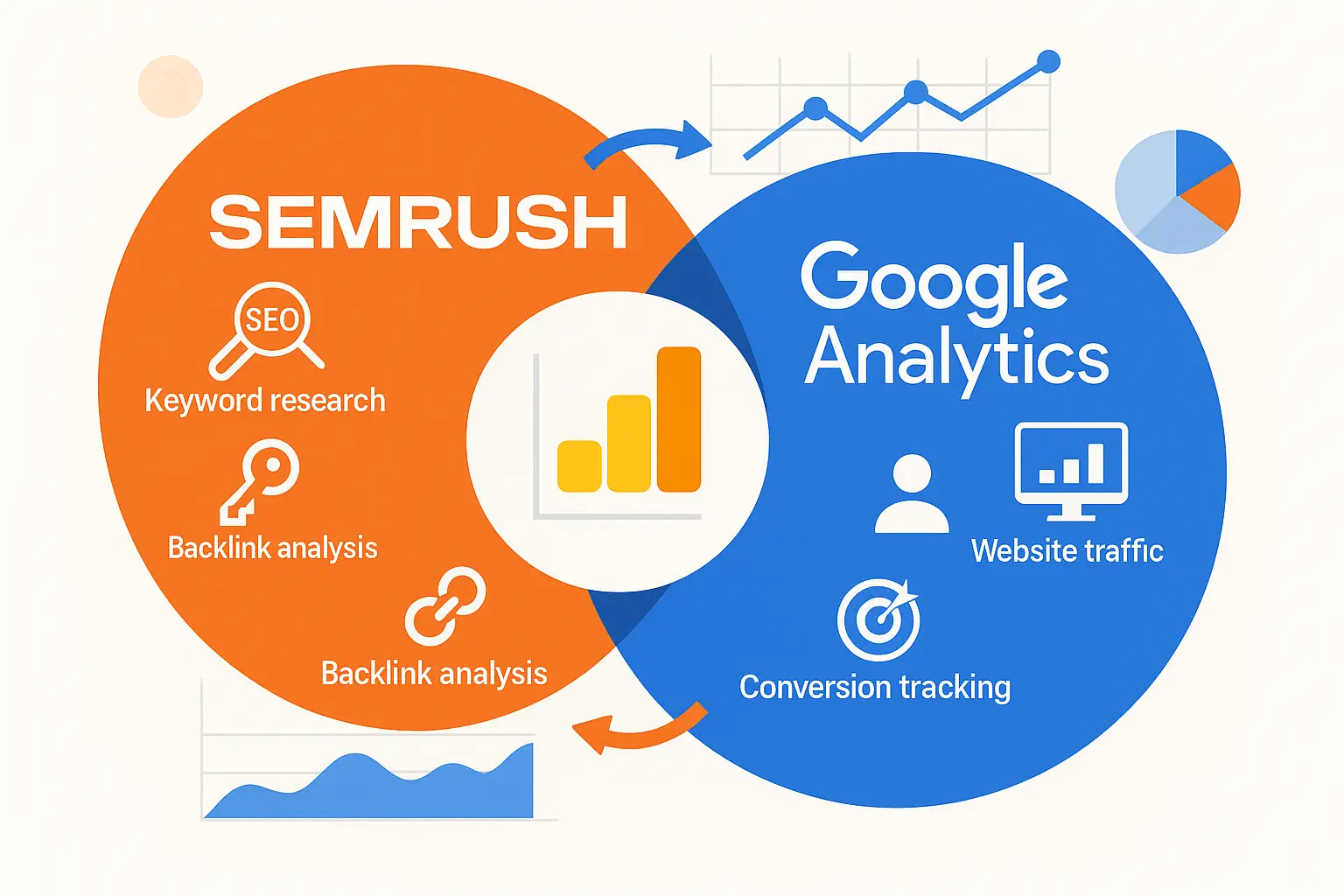How SEMrush and Google Analytics Can Work Together: A Powerful Combination for Digital Marketing Success
In the world of digital marketing, data-driven decisions are crucial for achieving success. With an abundance of tools available, it can sometimes be overwhelming to know which ones will provide the most valuable insights. Two powerful tools that marketers often use together are SEMrush and Google Analytics. When used together, they can provide a comprehensive picture of your website’s performance and help optimize your digital marketing strategies.
Let’s explore how these two tools can work hand in hand and the benefits of using them in tandem.
What is SEMrush?
SEMrush is a popular tool primarily used for SEO (Search Engine Optimization), PPC (Pay-Per-Click), and competitive analysis. It provides insights into keyword research, backlink analysis, site audits, and more. SEMrush can help identify opportunities to improve your website’s search engine rankings, track competitors’ strategies, and discover the most profitable keywords.
What is Google Analytics?
Google Analytics is a web analytics tool that tracks and reports on website traffic. It provides a wealth of information about user behavior, demographics, traffic sources, and conversion tracking. Marketers use Google Analytics to analyze website performance, understand how users are interacting with their content, and measure the effectiveness of marketing campaigns.
How SEMrush and Google Analytics Can Work Together
While SEMrush focuses on tracking keywords and SEO, Google Analytics gives insights into how users behave on your website once they arrive. By combining the strengths of both tools, you can create a powerful data-driven strategy for your website.
Here’s how they can complement each other:
1. Keyword Analysis & User Behavior
Example: Let’s say you’ve used SEMrush to identify a keyword that you want to rank higher for, such as “best digital marketing tools.” SEMrush tells you the search volume, competition level, and potential traffic that this keyword could bring.
Now, you can use Google Analytics to track the behavior of users who enter your website using this keyword. For example, if you notice high bounce rates for visitors coming from that keyword, you may want to optimize the landing page for better user engagement. SEMrush will guide you on what keywords to target, while Google Analytics will tell you how well those keywords perform once users land on your site.
How it works together:
SEMrush gives you the keyword data.
Google Analytics tracks how users interact with your pages and provides insights on bounce rates, time spent on page, conversions, etc.
Together, you can optimize both keyword strategy and on-page user experience.
2. Competitive Analysis & Traffic Insights
SEMrush is incredibly valuable for performing competitive analysis. It shows how your competitors rank for different keywords, what backlinks they have, and their overall SEO strategy. Google Analytics, on the other hand, shows how your website is performing in terms of traffic, conversions, and user demographics.
Example: After conducting competitive research with SEMrush, you find that your competitors are ranking well for certain keywords but not necessarily getting high traffic from social media channels. You can use Google Analytics to track where your own traffic is coming from, and if you notice that social media traffic is low, you can focus more on social media marketing to drive additional traffic.
How it works together:
SEMrush shows competitor keywords and backlinks.
Google Analytics helps you identify your traffic sources and how those sources are performing.
Use both insights to outperform your competitors by focusing on your strengths.
3. Backlink Strategy & Traffic Quality
Backlinks play a significant role in SEO, and SEMrush offers tools for tracking and analyzing your backlinks. It can show which websites are linking to you, and help identify opportunities for more backlinks.
Example: SEMrush shows you a competitor’s backlink profile, revealing high-quality sites that link to them. You decide to focus on getting backlinks from similar sites. After securing a few new backlinks, you use Google Analytics to track the organic traffic growth from these backlinks. If you see that traffic from these specific domains increases, you can conclude that the backlinks are having a positive impact on your site’s SEO.
How it works together:
SEMrush helps you identify high-quality backlinks and track competitor backlinks.
Google Analytics lets you monitor the effect of new backlinks on traffic and engagement.
This combined data allows you to optimize your backlink acquisition strategy.
4. On-Page SEO Optimization & User Engagement
SEMrush provides insights into on-page SEO, suggesting improvements like fixing broken links, optimizing meta descriptions, or improving the keyword density on your pages.
Example: After running an SEO audit in SEMrush, you find that certain pages on your website are not optimized for mobile users. You then use Google Analytics to check the mobile traffic statistics and see that mobile users have a higher bounce rate on those pages. This tells you that improving mobile optimization will be critical in retaining visitors.
How it works together:
SEMrush helps you identify on-page SEO issues.
Google Analytics provides insights on how users interact with those pages, such as bounce rate, session duration, and page views.
Together, you can improve the user experience and boost engagement.
5. Measuring Campaign Success & ROI
Both tools can be used to track the effectiveness of your marketing campaigns, be it SEO, paid ads, or email marketing.
Example: SEMrush shows you the performance of your paid Google Ads campaigns, including the keywords that are bringing in the most clicks and conversions. You can then use Google Analytics to monitor conversion rates for users who clicked on those ads. By combining SEMrush’s paid ad insights with Google Analytics’ detailed conversion data, you can calculate the ROI of your campaigns.
How it works together:
SEMrush tracks paid campaign performance.
Google Analytics tracks conversions and goals.
Together, they help you assess the return on investment (ROI) for each marketing effort.
Conclusion
When used together, SEMrush and Google Analytics provide a comprehensive and powerful toolkit for digital marketing success. SEMrush excels at giving you detailed insights into SEO, keyword performance, and competitive analysis, while Google Analytics offers deep insights into user behavior, traffic sources, and conversion tracking.
By combining the two tools, you can develop a well-rounded strategy that not only targets the right keywords and improves SEO but also enhances user engagement and ensures your campaigns are driving real business results.


